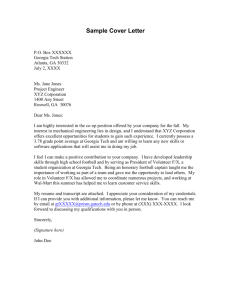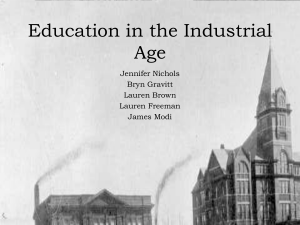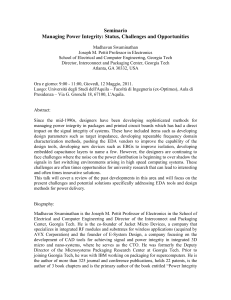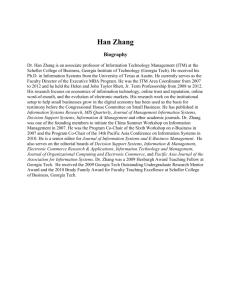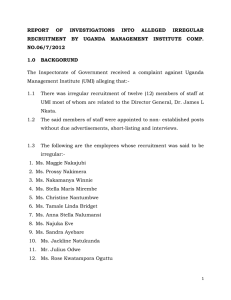Mise en page 1
advertisement
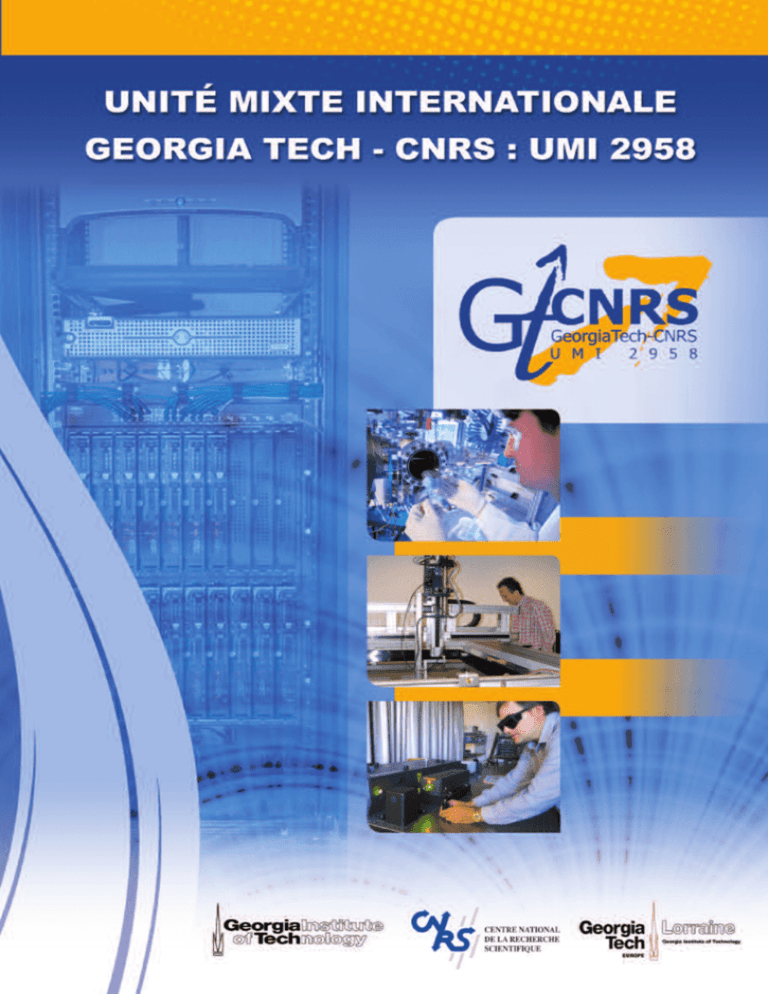
Georgia Tech is a State university located in Atlanta, Georgia, USA. The Atlanta campus enrolls 18,000 students, including more than 4,000 engineering students. Regularly ranked among the top five U.S. engineering schools, Georgia Tech is the largest producer of engineers in the USA and a leader in international research and education. The National Center for Scientific Research (CNRS) is a public organization for fundamental research. Present in more than 1200 Georgia Tech is committed to cutting edge research and technology transfer to industry. CNRS and the Georgia Institute of Technology, based in Atlanta and represented in Europe by Georgia Tech Lorraine, jointly created the UMI (the International Mixed Unit)-CNRS (UMI 2958) in 2006. Two prestigious university-level engineering colleges, ENSAM and SUPELEC, and two universities, the University of Franche-Comté in Besançon and the Paul Verlaine University of Metz, are associated members. The UMI plans to expand research in the telecommunications field, nanotechnologies, and functional materials. • Research fields : Secure networks and innovative materials. • Areas of application : Aeronautics, Automobile, Biomedical, Energy, Information security… UMI ATLANTA : The UMI has a physical presence at Georgia Tech Atlanta. UMI scientist visitors have access to the MicroElectronic Research Center (MIRC) and Marcus Nanotechnology Center (MNC). The UMI lab at GT Atlanta provides an excellent opportunity to our scientists and students to take advantage of the state-of-the-art equipment at these centers, to establish a deeper and longer lasting relationship with research groups at GT Atlanta, and to participate in US research programs. FEMTO-ST/UMR 6174: UFC, ENSEM, UTBM LMOPS/UMR 7132 : UPVM, SUPELEC Research areas : Micro- and nano-technologies, telecommunications, biomedical, transportation and sustainable development, industrial engineering. Research areas : Nitride thin films and materials for UV, waveguides and microstructures on lithium niobate, writing of photorefractive waveguides, optical sensors. Contact : FEMTO-ST, 32 avenue de l’Observatoire 25044 BESANCON CEDEX Tél : +33(0) 81 85 39 99 • www.femto-st.fr Contact : Université Paul Verlaine SUPELEC 2 rue Edouard Belin - 57070 METZ Tél. : 03 87 37 85 57/58 www.Imops.supelec.fr research and ser vice units that cover all of France, CNRS extends its activity into all scientific, technological, and societal domains. Georgia Tech Lorraine (GT-L) is the European Campus of the Georgia Institute of Technology (Georgia Tech). It is located in Metz, France, at the heart of western Europe. Created in 1990, GT-L is located on the Metz Technopôle, a site dedicated to research, education and high tech companies. GT-L's mission is to create innovative collaborations in research, education, and economic development with European partners. GT-L is devoted to the education of high potential, multi-cultural engineers able to face new challenges in an increasingly global economy. LPMM/UMR 7554 : UPVM, ENSAM, INPL, ENIM Research areas : Micromechanics and material properties, modeling and simulation of forming processes, dynamics and processes of high speed manufacturing, adaptive systems and vibration control. Contact : Université Paul Verlaine ISGMP Ile du Saulcy - 57045 METZ Cedex 01 Tél. : 03 87 31 53 60 • www.Ipmm.univ-metz.fr The UMI has made significant progress in its research activities, in building state-of-the-art facilities, in contributing to local, national, and international programs, and in establishing relationships with academic and industrial partners. This comes from the true strength of the lab its people. Our outstanding researchers, students and staff enable us to achieve significant milestones. We are undertaking major scientific initiatives with our associated members and partners to pursue a high quality research program, to attract the best scientists and students, and to contribute to economic development and technology transfer in Lorraine and Georgia. We are very grateful for the support of Georgia Tech, CNRS, and the local authorities of the Region Lorraine in sponsoring an exceptional lab with a vibrant international flavor and excellent opportunities for our scientists and students. .. COMPUTER SCIENCES Smart environments are of major interest from a scientific as well as a societal point of view. They are dedicated to enhance human quality of life, social and digital inclusion and to enable dependent persons (e.g. disabled or elderly people) to be assisted at home. Joint project between the Georgia Tech’s College of Computing and SUPELEC covers : • Human Interaction with Smart Spaces • Social and Physical Interaction for Human-Centred Robotics. SECURE CHAOS-BASED OPTICAL COMMUNICATIONS Chaos-based optical communications provide security to the physical layer of telecommunications networks. They exploit the inherent nonlinearities of a semiconductor laser to generate an optical chaos which is used to mask an information-bearing message. Our lab develops techniques that make this type of communication more secure and that enable the simultaneous encryption of several messages. QUANTUM KEY DISTRIBUTION Securing the last mile and everything inbetween : Experimental and theoretical research is underway to increase the speed and reliability of quantum key distribution, a method using optical communications to establish secret keys with perfect security immune to all possible mathematical or computational breakthroughs. Experimental and theoretical investigations of RF and RFID tag systems making use of principles of physical layer security are also being actively pursued. ULTRASONIC CHARACTERIZATION SENSORS Ultrasound is not only a useful inspection tool for classical materials, but also for new novel materials that may be highly complex and require sophisticated techniques. Within the framework of developing innovations that can be applied to the ultrasonic evaluation of new materials, the research of the Laboratory for Ultrasonic Non-destructive Evaluation follows the three following themes: the development of innovative techniques involving polar scanning and nonlinear acoustics, the interaction of ultrasound with periodic structures, and the development of innovative air-coupled ultrasonic transducers using piezoactive polymer foams. NLO FOR QUANTUM COMMUNICATIONS Novel nonlinear optical devices are being invented, designed, fabricated, and tested, primarily for applications in quantum communications. Investigations are focused on waveguides using the third-order nonlinearity for pure third harmonic generation, third-order parametric amplification, and novel structures for four-wave-mixing. RESEARCH GROUP ON MULTIFUNCTIONAL MATERIALS Designing a material to achieve a desired set of physical properties (coupled thermal, mechanical, electrical, magnetic, and transport) requires a deep understanding of multi-scale multi-physics science including modeling, scale transition techniques and characterization. Our research bridges disciplines and unites researchers from Georgia Tech and European Institutions to design multi-functional materials for efficient devices and systems. NEW MATERIALS AND NANO STRUCTURES FOR PHOTONICS AND ELECTRONICS Study of materials and devices structures based on B(AlGaIn)N grown by metalorganic vapor phase epitaxy (MOVPE). Design, simulation and growth of : • HEMT transistors structures, • Deep UV laser structures, • Near UV and visible range solar cells, • Nanostructuring of III-nitride materials by selective area growth (nano-SAG).
